Although its origin is obscure, popular legend claims that the evolution of karate began at the end of the 5th century A.D. when a Buddhist priest named Bodhidharma  travelled to China from India where he began teaching a combination of Indian fist fighting and yoga to the monks at the Shaolin Monastery. Bodhidharma’s teachings later became the basis for a number of Chinese kung-fu styles. travelled to China from India where he began teaching a combination of Indian fist fighting and yoga to the monks at the Shaolin Monastery. Bodhidharma’s teachings later became the basis for a number of Chinese kung-fu styles.
These fighting techniques were eventually transported to Okinawa by a group of Chinese immigrants, who settled there in the late 13th century. They shared their knowledge of the various Chinese arts, which included the fighting art, with the Okinawans. In those early days, these combat systems were known as Te (hand).
When the Shimazu clan of Japan invaded the Okinawan islands in 1609 they banned all residents from owning or carrying weapons, which enhanced the development of unarmed combat among the Okinawans. These fighting styles continued to develop over the years primarily in three Okinawan cities: Shuri, Naha and Tomari. Within each of these communities, a different form of Te developed and, eventually, they became known as Shuri-te, Naha-te and Tomari-te, respectively. Gradually, these empty handed fighting systems evolved into two major groups: Shorin-ryu, which developed around Shuri and Tamari, and Shorei-ryu, which was practiced around the Naha area. islands in 1609 they banned all residents from owning or carrying weapons, which enhanced the development of unarmed combat among the Okinawans. These fighting styles continued to develop over the years primarily in three Okinawan cities: Shuri, Naha and Tomari. Within each of these communities, a different form of Te developed and, eventually, they became known as Shuri-te, Naha-te and Tomari-te, respectively. Gradually, these empty handed fighting systems evolved into two major groups: Shorin-ryu, which developed around Shuri and Tamari, and Shorei-ryu, which was practiced around the Naha area.
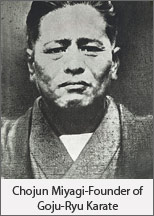 Although both of these systems had similar basics, the emphasis was somewhat different. Shorin-ryu emphasized quick linear movements with natural breathing, while Shorei-ryu emphasized solid rooted movements with breathing in harmony with each technique. Although both of these systems had similar basics, the emphasis was somewhat different. Shorin-ryu emphasized quick linear movements with natural breathing, while Shorei-ryu emphasized solid rooted movements with breathing in harmony with each technique.
Over time, these arts collectively became known as karate-te jutsu or Chinese hand art. Gichin Funakoshi (father of modern karate), who settled In Japan in the 1920s, later changed its name to karate-do – “way of the empty hand.”
Karate in Okinawa did not get much public exposure till 1905 when Anko Itosu, a 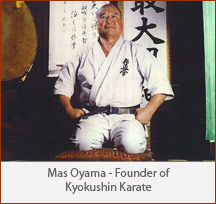 karate master, introduced this fighting art into an Okinawan junior high school. He developed a systematic method of teaching karate and created a number of katas (forms) that school children could master. Regarded as the grandfather of modern karate, Itosu taught many students who later became leading masters of karate. karate master, introduced this fighting art into an Okinawan junior high school. He developed a systematic method of teaching karate and created a number of katas (forms) that school children could master. Regarded as the grandfather of modern karate, Itosu taught many students who later became leading masters of karate.
One of Itosu’s students, Gichin Funakoshi, exposed karate to the outside world in 1917 when he travelled to Japan where he demonstrated karate at the Botukuden (Martial Virtues Hall) in Kyoto. This was the first time karate was seen outside of Okinawa, and, while the demonstration was successful, there was no immediate rush to bring karate to Japan. Things changed on 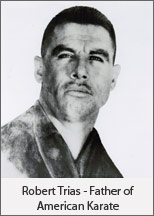 March 6, 1921 when the Japanese Crown Prince Hirohito visited Okinawa and witnessed a karate demonstration by Funakoshi. The Prince was so impressed and spoke so excitedly about what he saw that in 1922 the Japanese Ministry of Education formally requested that a karate demonstration be give at the First National Athletic Exhibition in Tokyo. Funakoshi was chosen to go to Japan and his demonstration was so successful that he was asked to prolong his stay. March 6, 1921 when the Japanese Crown Prince Hirohito visited Okinawa and witnessed a karate demonstration by Funakoshi. The Prince was so impressed and spoke so excitedly about what he saw that in 1922 the Japanese Ministry of Education formally requested that a karate demonstration be give at the First National Athletic Exhibition in Tokyo. Funakoshi was chosen to go to Japan and his demonstration was so successful that he was asked to prolong his stay.
Funakoshi stayed in Japan and soon decided to settle there, so he could continue to promote karate to the Japanese.
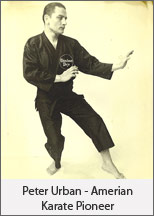
The art quickly caught on especially at the Universities and soon many other Okinawan karate masters traveled to Japan to spread the art. Among them were Kenwa Mabuni (founder of Shito-ryu karate), Chojun Miyagi (founder of Goju-ryu karate), Kanken Toyama (founder of Shudokan karate), Kanbun Uechi (founder of Uechi-ryu karate) and Motobu Choki. Each of these masters taught karate slightly differently and by the late 1930s there were numerous karate styles practiced In Japan. The best known of these were Shotokan (headed by Gichin Funakoshi), Shito –ryu (Kenwa Mabuni), Goju-ryu (Chojun Miyagi) and Wado –ryu (headed by Hironori Ohtsuka). In 1957 Mas Oyama founded Kyokuskin karate, which also became widely popular.
 Following World War II, a number of American servicemen stationed in Japan and Okinawa began studying karate. When they returned to the U.S., many started teaching martial arts. The first serviceman to open a karate school in the U.S. was Robert Trias, a Navy veteran. In 1946 he launched his karate school in Phoenix, Arizona. Two years later, Trias founded the U.S. Karate Association, which had thousands of members within a few years. Following World War II, a number of American servicemen stationed in Japan and Okinawa began studying karate. When they returned to the U.S., many started teaching martial arts. The first serviceman to open a karate school in the U.S. was Robert Trias, a Navy veteran. In 1946 he launched his karate school in Phoenix, Arizona. Two years later, Trias founded the U.S. Karate Association, which had thousands of members within a few years.
By the late 1950s a fair number of highly respected American karate instructors opened schools. Among these early karate  pioneers the best known included Ed Parker (Southern California), William Dometrich (Kentucky), Bruce Tegner (Southern California), Don Nagle (New Jersey), Louis Kowalsky (St. Louis), Cecil Patterson (Tennessee), Ed Kaloudis (New York), Peter Urban (New York), Robert Fusaro (Minnesota),George Mattson (Boston), Phillip Koeppel (Midwest), Dan Ivan (Southern California) and Steve Armstrong (Seattle). pioneers the best known included Ed Parker (Southern California), William Dometrich (Kentucky), Bruce Tegner (Southern California), Don Nagle (New Jersey), Louis Kowalsky (St. Louis), Cecil Patterson (Tennessee), Ed Kaloudis (New York), Peter Urban (New York), Robert Fusaro (Minnesota),George Mattson (Boston), Phillip Koeppel (Midwest), Dan Ivan (Southern California) and Steve Armstrong (Seattle).
Because karate was gaining popularity, a number of high ranking Japanese karate masters decided to settle in the U.S. during the early 1960s. Within a short time, they had a very large following and elevated  the standards of karate practice considerably. The best known of these masters included Tsutomu Oshima (Los Angeles), Hidetaka Nishiyama (Los Angeles), Teruyuki Okazaki (Philadelphia), Fumio Demura (Aneheim, California), Gosei Yamaguchi (San Francisco), Takayuki Mikami (New Orleans), Hidy Ochai (New York) and Takayuki Kubota (Los Angeles). By the late 1960s, karate was practiced by tens of thousands of Americans not only as a means of self defense, but also as a major competitive sport. Each year hundreds of tournaments were held and many American karate champions became famous. Among the best known early champions were Chuck Norris, Joe Lewis, Skipper Mullins, Allen Steen, Frank Smith, Mike Stone, Bill “Superfoot” Wallace and Ron Marchini. the standards of karate practice considerably. The best known of these masters included Tsutomu Oshima (Los Angeles), Hidetaka Nishiyama (Los Angeles), Teruyuki Okazaki (Philadelphia), Fumio Demura (Aneheim, California), Gosei Yamaguchi (San Francisco), Takayuki Mikami (New Orleans), Hidy Ochai (New York) and Takayuki Kubota (Los Angeles). By the late 1960s, karate was practiced by tens of thousands of Americans not only as a means of self defense, but also as a major competitive sport. Each year hundreds of tournaments were held and many American karate champions became famous. Among the best known early champions were Chuck Norris, Joe Lewis, Skipper Mullins, Allen Steen, Frank Smith, Mike Stone, Bill “Superfoot” Wallace and Ron Marchini.
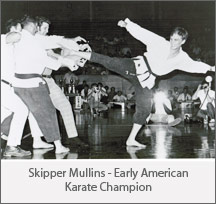
In Europe karate first appeared in the early 1950s when Henry Plee opened a karate school in Paris. He invited numerous high ranking Japanese karate masters to teach at his academy and within a few years karate was practiced all over Europe. By 1966 the European Karate Union was established and karate competition between various nations became common. The sport grew to such proportions world wide that in 1970 the first World Karate Championships were held in 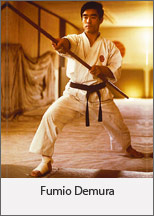 Tokyo. By the 1970s millions of karate students were training in dojos (schools) all over the world. The majority of these students studied karate for self-defense, while others got into the art for the sport or for its other benefits, such as getting in shape or relieving stress. Tokyo. By the 1970s millions of karate students were training in dojos (schools) all over the world. The majority of these students studied karate for self-defense, while others got into the art for the sport or for its other benefits, such as getting in shape or relieving stress.
With the explosion of martial arts movies in Hollywood during the 1970s and ’80s, karate got an even greater boost. Martial arts stars, such as Chuck Norris and Claude Van Damme, along with the icon Bruce Lee, became household names internationally and enrollment at karate schools increased dramatically. In 1984 the film Karate Kid was so successful that soon karate schools were full of children eager to train and become future black belts.
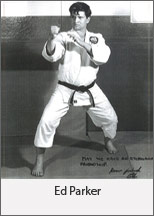
By the beginning of the 21st century, karate became the most widely practiced martial art in the world, a far journey from its secretive roots in ancient Okinawa.
A journey of a thousand miles begins with a single step – Confucius
Emil Farkas
|

